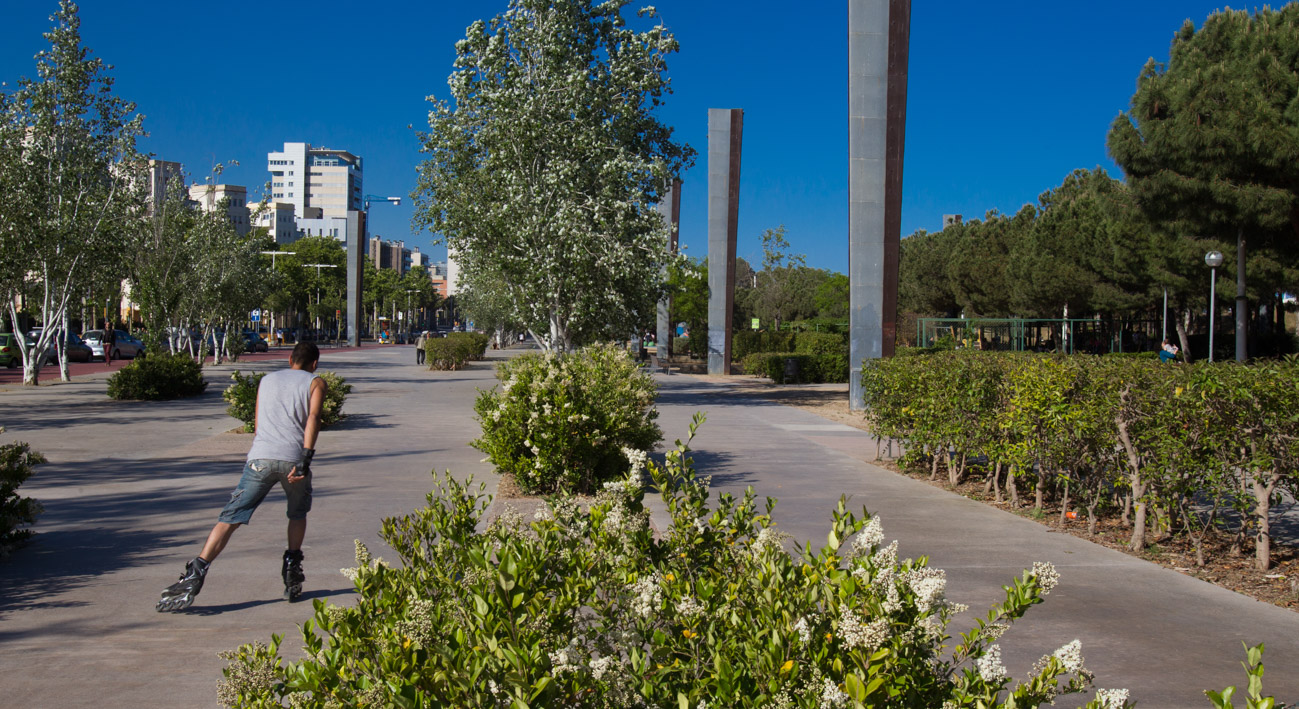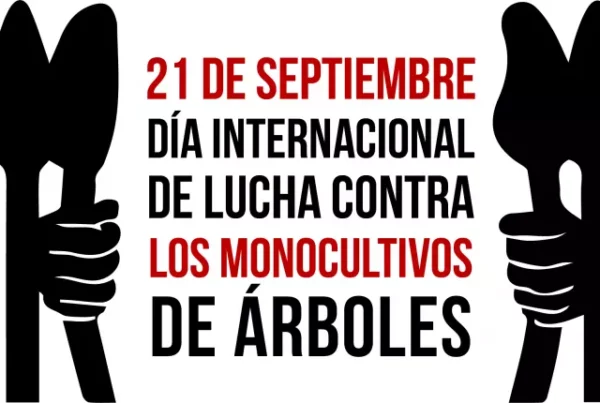By Michele Catanzaro*
The creation of city parks, green belts and ecological corridors in urban neighbourhoods attracts upmarket estate agencies and new residents with more purchasing power than longstanding residents. The rise in housing prices pushes the original population out: a frustrating phenomenon known as “green gentrification”.

Parc del Poblenou, Barcelona. Source: LaMevaBarcelona.cat
Barcelona’s Parc del Poblenou is the kind of project that everyone would like to live close to: a large green space in a historical and popular neighbourhood with industrial past. But the park has brought about unexpected consequences. The number of residents with a university education has increased by 700% in a 100 metre radius around the site. The number of elderly residents and immigrants from the global south has fallen. Luxury dwellings have sprung up, and housing prices have shot through the roof. In a nutshell, the community that was to benefit from the park has been moved aside to make room for new, richer, younger and whiter residents.
This is Barcelona’s most blatant example of a frustrating boomerang effect known as “green gentrification”. The creation of city parks, green belts, ecological corridors, etc. attracts upmarket estate agencies and new residents with greater purchasing power, while the rise in housing prices ultimately pushes out the original working-class population. Deprived communities campaign for greener neighbourhoods, but when they achieve their objective they find themselves driven out to less attractive areas.
This phenomenon has occurred in a number of places, including the new green belt of Medellín (Colombia), the redeveloped waterfront of Portland (Oregon, United States) and the brand new High Line (New York City), a park built on a disused section of elevated train track. It is as though the most aggressive mechanisms of the market economy had put themselves at the service of environmentalism, sustainability and the fight against climate change.
“Before, economic factors worked against environmental factors, but today the big property corporations have found ways to cash in on the green agendas of cities”, says Isabelle Anguelovski (Reims, France, 1978), a researcher in political ecology at the Institute of Environmental Science and Technology of the Universitat Autònoma de Barcelona (ICTA-UAB). Anguelovski, having identified “green gentrification” phenomena on both sides of the ‘pond’, has become the go-to expert in this area. She worked at the Sorbonne, at Harvard University and at the Massachusetts Institute of Technology (MIT) before settling in Barcelona in 2011. In 2013 she won the Catalan Regional Government’s National Research Prize for Young Talent.
Over the next five years, she will be analysing the process in forty cities around the world as part of the Greenlulus (Green Locally Unwanted Land Uses) project, which has received €1.5 million in funding from the European Commission’s European Research Council (ERC). The researcher also hopes to find success stories in cities where a balance has been struck between social justice and nature. These examples could prove valuable when the time comes to deal with the next candidates for green gentrification in Barcelona: the Parc del Calaix de Sants and the city’s superilles, or “superblocks”. Anguelovski is advising the City Council on this issue.
You describe yourself as an activist researcher. What does that mean?
It means having an in-depth understanding of the social realities that I study and helping to resolve some of the more acute sources of tension. In Boston, I worked in Dudley, a deprived neighbourhood that for decades has experienced arson attacks perpetrated to empty out rented flats, as well as an accumulation of rubbish and a lack of interest on the part of investors. Afro-American, Afro-Latino and Cape Verdean communities campaigned to improve the quality of the neighbourhood. I worked with them and shared the results of my research. In Barcelona, I haven’t had such an activist role. With two small children, it’s not so easy. But I always share information with the organisations I study. I also hold workshops and write for the press. And I’m also working with the City Council to prevent green gentrification in the superblocks and the in gardens of Sants.
Have you always combined research with frontline involvement?
At the age of nineteen, I used the Spanish I’d learnt at high school to travel to Cuba with a Madrid-based NGO, Sodepaz. I was shocked by the problem of developmental inequality. During my degree [in political science at Sciences Po Lille (France)] and Master’s [in development cooperation at the Sorbonne] I often went to Latin America on cooperation projects. Later on, I worked with Oxfam to help women deal with the effects of mining. This was my first exposure to environmental injustice. I also set up an NGO that offered advisory services to indigenous communities affected by mining.

Neighborhood as refuge. Source: MIT Press.
Have you been studying the relationship between justice and the environment since then?
After a few years, in 2006, I started a PhD at MIT on conflict resolution between environmental offenders and affected communities. It resulted in a book published in 2012 [Neighborhood as Refuge: Community Reconstruction, Place Remaking, and Environmental Justice in the City] where I compare cases from neighbourhoods in three cities: Dudley in Boston, Sant Pere and Santa Caterina in Barcelona and Cayo Hueso in Havana.
What do Barcelona, Boston and Havana have in common?
I’d realised that many deprived communities work on environmental issues. They clean up land, create green spaces, set up workshops with recycled materials and work with renewable energy. This happens in communities that have nothing at all in common. I wanted to understand why and how communities that have historically been stigmatised and marginalised actually mobilise. Not by comparing neighbourhoods in the same city, but by comparing very different political situations.
Why did you choose Barcelona as a case study?
I’d already visited the city in 2000 and gone around the neighbourhoods. Since then, I’d come back several times and had followed the urban development. The objective of my work was to compare the movements in Boston, which has a well-established democracy and a high level of urban development, with those in Barcelona, which has a young democracy and an intermediate level of development, and Havana, which has an underdeveloped autocratic regime.
What do the environmental movements of these three cases have in common?
After conducting 150 interviews, I can say they have a lot in common. The sense of abandonment experienced by people in these neighbourhoods creates a connection between people and places. A kind of twofold awareness emerges: firstly, they understand the problems they suffer from; secondly, and paradoxically, they also have a sense of belonging, a sense of community and a pride about living in their neighbourhoods. This generates a sense of responsibility, an interest in improving the quality of the urban environment and personal growth, even in people with no formal education or profession. The objectives of these movements are to remake their surroundings and reinforce their identity. Caring for the environment is a tool to help them achieve other goals. They’re looking to fix the environment but also to create a sense of protection from racism or drugs, to set up a kind of urban village and to celebrate a sense of community. The neighbourhood becomes a refuge, a safe sanctuary. This is a really important factor, especially for the youngest residents.
How does this idea of neighbourhood as refuge play out in Barcelona?
I focused mostly on El Forat de la Vergonya. Despite the conflicts with the council and between the groups involved, I think they’d managed to create a space run by the citizens that had social and cultural diversity, locally-owned shops, etc. Things have changed now. El Forat and the social housing are like an island cut off from the rest of the neighbourhood. All around it, there has been major social breakdown. There are no shops selling products for the residents. Instead there are art shops, smoking clubs, electric bike hire places and bars selling patatas bravas at €8. This preference for the “Barcelona brand”, the reduction in citizen participation that occurred during Mayor Trias’ term in office and the financial crisis have all led to a scenario where only outsiders invest in the neighbourhood. New hotels have been built to attract tourism, but rental properties are scarce and most of them are for tourists. It’s also a fact that the people who led the fight at El Forat have grown old or have left. There are nonetheless some new, emerging activist initiatives.
After moving to Barcelona, you became interested in bottom-up initiatives to combat climate change.
Yes, I was a principal investigator on TESS, a European project that set out to measure the impact of grass-roots initiatives in mobility, food, energy and waste across six countries. In Barcelona, I studied associations, cooperatives and companies like Can Masdeu, La Col, Can Batlló, Trèvol, La Ortiga, Tota Cuca Viu, Granja Aurora, Som Energia, and so on.
How did the idea of “green gentrification” come about?
It arose towards the end of my fieldwork for the book. Many activists were telling me things such as: “We fought to clean up our neighbourhood, which was polluted and neglected. Now we finally have environmental infrastructure and see that the neighbourhood is attracting investors and new residents”. There were people who said that if they put in another community garden, they’d have to leave in five years, or that their neighbourhood was green enough already. At El Forat de la Vergonya, they tipped sand on the ground to stop café terraces from being set up. Many movements shifted their focus from environmental justice to housing. It was then that I saw the contradiction and the paradox that these people were facing. The scientific literature on the subject was in its very early stages, and only a few very specific individual case studies existed.

Isabelle Anguelovski. Photo by Pere Virgili.
When did this process begin in Barcelona?
The first documented cases are from the late 1990s, Vila Olímpica being one of them. I’m also thinking about researching cases from the 1980s, such as Parc de Joan Miró and Parc de l’Espanya Industrial, but there’s not much data.
And where are the hotspots today?
Firstly, there are the gardens on Rambla de Sants, where some residents are already fearful because their homes are more visible to tourists. And there’s already the precedent of the High Line in New York. Secondly, the superblocks. I’m on the study group set up by the council to mitigate any of their negative effects. But there are other examples, too, like Passeig de Sant Joan. It has never been a low income area, but it suffers from supergentrification. In other words, the middle classes are being displaced by people with even higher incomes.
Is green gentrification the result of a deliberate strategy by property companies?
The companies are fully aware of the power of green. In Vancouver, powerful construction firms advertise luxury buildings with communal gardens inside. The big estate agencies of Germany advertise properties in Barcelona, emphasising the green space. It’s not just about building or redeveloping luxury buildings. It’s simply that high-income people and families are attracted to beautiful parts of the city.
What role does politics play?
Sustainability has been de-politicised. Green planning is viewed as technocratic, post-political, apolitical, top-down. A park or a High Line-type project is created and it’s assumed that everyone will benefit. There’s no critical analysis of the situation to find out which stakeholders really do benefit. The fact that powerful investors have taken over the ecological agenda is ignored by political discourse.
You have said that a greenlulu (unwanted green space) could be even worse than a brownlulu (polluted or deteriorated space). How can that be?
Well, yes, in a certain way it can be like that. Green gentrification can be worse than a polluting factory because of the forced displacement it imposes. People lose their social networks and are forced to move far from the city centre, where it’s harder for them to find work or get around. And everyone knows that a brownlulu is bad, while greenlulus are seen as positive, which makes it more difficult to put research into the problems they cause on the agenda.
At least these green spaces help to make cities more sustainable?
The agenda to make the city greener doesn’t necessarily coincide with the sustainability agenda. The latter requires energy policies, an aggressive sustainable transport strategy, strong commercial networks of shops within the city, well distributed schools and health facilities, etc., so that people have amenities nearby and don’t need to travel so much.
Is there any way of keeping the benefits of green spaces in cities without creating injustices?
Basically, it’s a question of coming up with resolute affordable housing policies. In Europe, there are more than three million empty homes. Spain is one of the countries with the highest rates of this. We need to find ways of spreading access to these spaces and reclaiming the buildings that have been repossessed by the banks. One way would be to create new forms of social housing. We don’t need to build more, we just need to increase the funds allocated to refurbishing existing buildings. And when there are new developments, one can set up inclusiveness zones. This has been done in Berlin and New York, cities where 20%-30% of new homes must be allocated to social housing. We also need to push forward vigorous policies that control and expand the rental market, because the speculation that is rife in the mortgage market means that sometimes people end up unable to pay back their loans. In this regard, we need to change the mindset that puts buying before renting. And we also need to reduce the number of licenses for tourist flats and control illegal rentals through platforms like Airbnb.
Does the key lie in developing good housing policy?
That and more. If there is one positive thing about gentrification it’s that neighbourhoods get regenerated. But how can we help residents to stay on? Basically, by improving their income. With that objective, we should be able to change the cycle of poverty already at school, by funding the most neglected schools and giving pupils an opportunity to find well-paid work in the future. It’s also important to have strong local merchant associations to defend the traditional shops. Finally, health centres can have a positive influence on the social determiners of health. It’s a whole set of actions that go together. It’s about putting a localised focus on policies of regeneration.
Nevertheless, the residents of areas that are at risk today need quick solutions.
In each place, one has to study the causes of gentrification. In Barcelona, it’s driven by a combination of tourism, property investment and trends which see upper class people moving or returning to the city. We need to revitalise neighbourhoods in crisis by, amongst other measures, providing loans to small businesses and controlling which shops can open. Maybe we don’t need another electric bike hire shop for tourists. Instead, we could prioritise businesses that provide services to local communities. And we’d also need to reach political agreements to set up zones of inclusiveness.
*Michele Catanzaro is a science journalist. This interview was originally published in Barcelona Metròpolis. Reproduced with permission.




